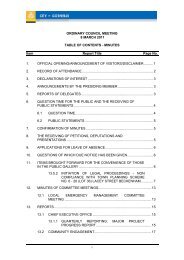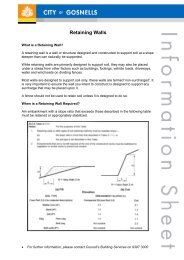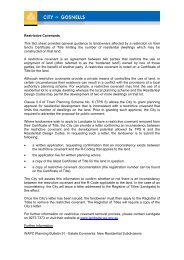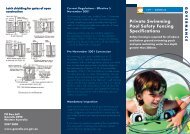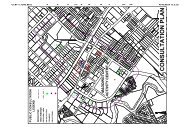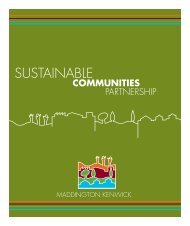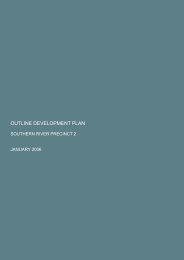CITY OF GOSNELLS
CITY OF GOSNELLS
CITY OF GOSNELLS
You also want an ePaper? Increase the reach of your titles
YUMPU automatically turns print PDFs into web optimized ePapers that Google loves.
MAKING THE <strong>CITY</strong> <strong>OF</strong> <strong>GOSNELLS</strong> A GREAT PLACE
FOREWORD BY DR ADAM GRAYCARCrime follows opportunity. Making crime harder tocommit by designing out opportunities can limitcrime significantly, as can considering the needs ofvulnerable people and ensuring strategies forgreater connectedness to community.These are the principles underpinning the City ofGosnells SafeCity Urban Design Strategy.When we look at the big picture we know that mostplaces have no crime, and most crime is highlyconcentrated in a relatively small number of places.Some shops have no robberies, while a few havelots. A few entertainment venues have manyproblems, most have none. Even in high burglaryneighbourhoods most residences have noburglaries, while a few suffer from repeatburglaries. Understanding crime ‘hot spots’ is veryimportant in developing preventative measures.Blocking criminal opportunities takes place byunderstanding place – its design and layout – andthe different strategies that are appropriate forhouses, flats, shops, warehouses, factories, publictransport, parks, pubs and other elements of thebuilt environment.Public space contains risks, but the risks can belessened by channelling movement patterns anddividing human activities into smaller and moremanageable chunks. Public spaces like parks andstreets should not be too large, and publicshopping or transport facilities or housingdevelopments shouldn’t have vast unassignedspaces. Manageable chunks can help providesocial control and thus crime control.In the City of Gosnells most housing is detachedand there is low pedestrian movement. As a resultthe planning lessons that can be learned fromoverseas experiences are not always applicable inAustralian cities. Furthermore we know that LocalGovernments do not have control over all of thefactors that make for an environment which fosterssafety and security. But they can be a positive forcefor change.We know that those who feel excluded fromparticipation in community life are more likely tooffend against that community. Councils’ willingnessto address this sense of exclusion can reduce therisk of offending, as can the complementarystrategy of reducing opportunities for crimes to becommitted through the design, planning andstructure of our neighbourhoods. Recognising thatthe physical environment influences the where andwhat of crime problems, designing naturalsurveillance, using building design to put more”eyes on the street“, focusing on natural accesscontrol and surveillance all contribute to creating asetting in which access control and surveillance arebrought about by the normal and routine use of theenvironment.The City of Gosnells has taken an enormous leapforward by building on its many years of dedicatedexperience and publishing this important guidewhich incorporates crucial design principles with arealistic understanding of the features that makepeople live comfortably and safely in a thrivingAustralian city. This is a most useful and innovativepublication, and a major contribution to betterdesign, safety enhancement, and the creation of acommunity in which we all feel comfortable inbeing able to go about our daily activities in arelaxed and uneventful manner.I congratulate the City of Gosnells on thispublication, but more importantly, on the values andcommitment that underpin it, and look forward tothe action that will flow from it.Dr Adam GraycarDirectorAustralian Institute of Criminology, Canberra2
INTRODUCTION BY THE MAYORWhy does a Local Government become involvedwith crime and community safety issues? Simplybecause the local community asked us to do so.In response to a customer satisfaction survey, theCity of Gosnells has been pro-active, with aninnovative study addressing the environmentalcomponents that affect crime. The Council has takena leadership role in setting up the SafeCity Initiativeand by commissioning a Space Syntax study, bothof which have far reaching implications.approach will pay off in the medium to longer term.The City of Gosnells is committed to taking amulti-faceted, long-term approach to how the builtenvironment and crime affect each other.Council is also committed to gaining the support oftown planners, architects and the wider communityto make the City of Gosnells a much safer place,and a local authority that others will look to, forhaving set the benchmark in this way.Very specific recommendations are contained in theCity of Gosnells SafeCity Urban Design Strategyresulting from our innovative work on sustainablecrime prevention. This is the strategy we would liketo pursue, from which policies and other initiativeswill be developed.We are looking at the 'big picture', and developingappropriate policies. The benefits will not alwaysbe immediately distinguishable, but they willbecome apparent over time. A far easier optionwould be to use reactive measures. These measurescan cost ratepayers millions of dollars and still notdeal with the core issues that allow crime to occur.It is our intent to deliver real solutions which canoffer tangible benefitsCr Patricia Morris JPMAYORThere is convincing data to suggest that theinvestment that Council has made in taking this3
DESIGNING OUT CRIME IN THE <strong>CITY</strong> <strong>OF</strong> <strong>GOSNELLS</strong>SafeCity URBAN DESIGN STRATEGYThis report gives the background to the City ofGosnells SafeCity Initiative and it also explains theSafeCity Urban Design Strategy.Because it links in closely with the SafeCity UrbanDesign approach, we also publish a summary ofthe findings of a study completed by researchers atSpace Syntax Ltd, London, on behalf of the City ofGosnells. This study sets a benchmark for the futureof urban design with respect to safety. (See page 5.)The Space Syntax document, “The Crime and UrbanDesign Database”, was delivered to the City ofGosnells in May 2001. It contains a good deal oftechnical information and will, therefore, havelimited release. It will be available, on request, toresearchers, and may be viewed at public libraries.The SafeCity initiative and the Space Syntaxfindings are part of a broader program. Bothshould be used in an on-going educational processto encourage deep consideration to be given to thespaces we design, thus making for safersurroundings.By spearheading the SafeCity initiative andcommissioning the Space Syntax study, the City ofGosnells is sending a clear message that it isfocused on, and committed to, taking a multifaceted,long-term, coherent approach to how thebuilt environment and crime are connected witheach other.Changing the urban form will not happen nextweek. Change, for the better, will occur gradually,and only with the support of Council and keystakeholders, including town planners, architectsand the wider community.Very specific recommendations have been made,which are not yet policy. From this strategy wewould like to pursue the incorporation of therecommendations into a range of policies.Although every effort has been made to keep thissummary report less technical, some terms havebeen used which may be unfamiliar to readers. Aglossary is provided at the end of this document.BACKGROUNDIn 1997, the Council undertook a community survey,asking ratepayers and residents to identify criticalissues that the City of Gosnells needed to address.Two main concerns were identified:1. Community safety (even though the rate ofcrime in the City of Gosnells was below theaverage rate in Western Australia).2. The Gosnells Town Centre needed to beimproved.Work on the Town Centre was undertaken, and theimpact of the ensuing Town Centre RevitalisationScheme was striking. The results have beenrecognised with numerous awards.To address concerns about community safety, the Cityof Gosnells Council took a leadership role in settingup a SafeCity Task Force to develop key partnerships,and coordinate the local efforts of the Council, StateGovernment agencies, local community organisationsand the WA Police.The SafeCity Initiative was launched, which includesa wide range of programmes and projects intendedto address both the perception and actual incidenceof crime.4
The various initiatives fall under three broadstrategies, namely:• An Establishment Strategy This involvedresearch into the nature of crime, enablingmore targeted crime prevention strategies to bedeveloped.The establishment research is essentially a“desk-top” inquiry into the nature of crime inthe City of Gosnells, and a comparison withother areas in the State, and other States inAustralia.It is a holistic approach, and should includeenvironmental redesign to reduce opportunities forcrime, as well as address issues such as:job creationthe improvement of choice andvariety of activities in the City of Gosnells.The SafeCity Initiative was described by the then WACommissioner of Police, Bob Falconer, as “the bestcommunity safety strategy in Australia”.The revitalisation of the Gosnells Town Centre is a key“early start” scheme in meeting these objectives.• A Bridging Strategy This incorporates shorttermmeasures to address priorities.The programmes are intended to diminish thenegative perception of crime in the City, as wellas address actual criminal patterns or crime“hot spots”.Fig 1. Gosnells Town Centre revitalisation - partial plan.• A Preventative Strategy This is a long-termstrategy to reduce crime.It involves detailed evidence-based research intocrime patterns, to identify the role the builtenvironment plays in crime reduction. “Designingout Crime” and CPTED (Crime Prevention ThroughEnvironmental Design) are the main directions thisstrategy takes.Fig 2. Gosnells Town Centre – vision for a new “Main Street”.5
STRATEGY CONTEXT AND IMPLEMENTATION PROCESSThis SafeCity Urban Design Strategy is intended toprovide a framework for policy development withinthe City of Gosnells. As a critical component of theCouncil’s broader set of strategic policies it will helpto guide future development and redevelopmentwithin the City.ImplementationThere are a number of implementation tools availableto Council, some of which it has direct control over,and others it can only seek to influence.SubdivisionWhile Local Government is required to comment onsubdivision proposals, the determining authority inWestern Australia is currently the Western AustralianPlanning Commission (WAPC).The guidelines for subdivision and communitystructure as outlined in this strategy are notenforceable by the City of Gosnells.Land Use and Development ControlsDevelopment and land use controls are determinedby the provisions of Council’s Town Planning Schemeand policies, which are developed in accordancewith the Scheme.The SafeCity Urban Design Strategy will form part ofCouncil’s Local Planning strategy, which will guideland use policy and changes to the Town PlanningScheme provisions.Local LawsSome aspects of the built environment that are notmanaged by the Town Planning Scheme or PlanningPolicy can be (or are) managed through Local Laws,which are enforced under the Western AustralianLocal Government Act 1995.The SafeCity Urban Design Strategy will guidechanges to the current Local Laws (e.g. fencing) aswell as the possible development of new Local Laws.The drawings and sketches shown are indicative,and are not meant to curb creativity or be astandard for architectural style in the City ofGosnells.The WAPC will, however, be guided by the provisionsof the City of Gosnells Town Planning Scheme andzoning context. This, in turn, will be influenced by theSafeCity Urban Design Strategy.The SafeCity Urban Design Strategy will also be usedto influence changes to the WAPC policies relating tosubdivision.6
SafeCity: DESIGNING OUT CRIMEDesigners are faced with an important choice when itcomes to improving safety performance and“designing out crime”.Two theories have emerged, which offer conflictingadvice:1. turn inwards and design segregated and enclosedenclaves, and barricade houses, streets andneighbourhoods, and2. design to connect and integrate areas andcommunities, and humanise streets andneighbourhoods.In recent times there has been an increase in thepopularity of “gated communities”, where wholeareas are cut off and segregated by closing streets,or walling suburbs in order to improve safety. This ishighly influenced by the Defensible Space theory andpractice developed by architect Oscar Newman(“Defensible Space” 1972), which has beenincreasingly criticised by researchers, designers andpolice forces.“Experience has shown that turninginward has actually increased crime.”(Wekerle & Whitzman, 1995, p53)The evidence-based research in the City of Gosnellssupports this concern. Designers, therefore, must aim to:• achieve connection and integration• improve surveillance• analyse the important social, economic andenvironmental consequences of design.Good design is not only essential to improve safety inhouses, streets, neighbourhoods and the City, but itcan help reduce costs to the broader community as itreduces the need for prisons or larger police forces.From the Establishment Strategy, research hashighlighted the nature of crime in the City ofGosnells. The greatest number falls into the categoryof “crimes against property” and includes homeinvasion, burglary, and vehicle theft. In these types ofcrime, the built environment and location aresignificant. Safety could therefore be improved bybetter design and management of the builtenvironment.The City of Gosnells recognised that taking a longtermview to improving the built environment wouldprovide the greatest potential for long-term success.However, to clearly understand the links betweencrime and design, the City commissioned researchersat Space Syntax, London, to work with them toanalyse over 20,000 crimes committed in the City ofGosnells during the period July 1997to July 1999.This innovative method of analysis began in 1998,and was a “first” for WA, and indeed, has brokennew ground in Australia. The use of GIS (GlobalInformation Systems) technology in conjunction withSpace Syntax techniques and crime data has alsobroken new ground internationally.The Space Syntax research clearly identifies how theenvironment contributes to some crimes. The SpaceSyntax report “The Crime and Urban DesignDatabase” was submitted to the City of Gosnells inMay 2001, and a summary of findings are publishedon pages 9 to 13.The SafeCity Urban Design Strategy draws on thefindings of this report, as well as other literature,design policies and strategies, to provide guidancefor policy and decision-making to help make the Cityof Gosnells safer over time.Beyond this strategy, the City of Gosnells will developa range of specific initiatives. These will includepromotional programmes, information to residentsand landowners, lobbying of State and FederalGovernments and other relevant external agencies,and new and modified planning policies and LocalLaws.7
WHAT IS SPACE SYNTAX?In the 1970s, Professor Bill Hillier initiated the “SpaceSyntax“ research programme at University CollegeLondon. Since then, he and his team have developedtechniques that analyse the relationship betweenspatial layout and function.Space Syntax research supports the view thatconnected and integrated areas can be safer thancomplicated, broken-up layouts. Studies have shownthat the key to making areas safer from burglary ishigh levels of “natural surveillance“ from residentsand, crucially, from passers-by on foot and invehicles. Space Syntax analysis objectively measureslevels of natural surveillance in urban layouts. Indoing so it provides a robust tool for studying andtackling crime.The key to the computer modelling technique is the“axial map“ (Fig 3). The axial map is constructed bydrawing the longest and fewest straight lines (or“lines of sight“) that pass through all the accessiblespace in an urban area on an accurate scale map.The resulting pattern of intersecting lines is thendigitised into the computer and all the interrelationshipsamong the lines are analysed so that anunderstanding of the spatial structure and features ofan area is built up.The most important measure for forecasting thepotential movement along a line is called “spatialintegration“. This is calculated by selecting a line onan axial map, and calculating how many other linesmust be used wholly or in part to reach every otheraxial line in the area being analysed. It turns out thatsome lines require fewer changes of direction thanothers in order to cover the rest of the axial map.These lines are “more integrated“.In every processed axial map each line has an“integration value“ assigned to it. This value reflectsthe complexity of routes from that line to all the otherswithin the system. This complexity affects pedestrianand vehicular movement potentials in two key ways.First, an integrated line is more easily accessible thana “segregated“ one because it can be reached bysimpler routes. Second, a more integrated line ismore likely to be selected as part of a route betweenother pairs of lines; that is, it will attract more throughmovement. It is the combination of their role in “to“and “through“ movement that gives “integrationvalues“ their power in helping to estimate movementpotential.Values of integration are converted by computer intoa coloured graphical representation called the“spatial integration map“ (Fig 4). The most integratedlines are automatically coloured red, then throughorange, yellow, green, to blue and deep blue for theleast integrated. The importance of graphicalrepresentation is that many functional properties ofthe layout (including movement, land use, land valueand urban safety potential) can be seen at a glance.Statistical analysis can then be used to confirm whatthe eye sees.In summary, Space Syntax analysis providesobjective, evidence-based tools for studying urbanareas and developing proposals for redesigningthese to promote successful space use and safety.Fig 3. Axial integration map and crime events (Space Syntax, May 2001).Fig 4. Land-use map and crime events (Space Syntax, May 2001).8
1.7 Differences in Road Types by Sub-AreaThere are very large differences by road type in thedifferent sub-areas. In Gosnells East, West andNorth, cul-de-sacs in general are less vulnerable thanthrough roads, while in Maddington and Thornliethey are the most vulnerable. In general “pure“ culde-sacsare also safer than “impure“, but in Kenwickthey are less safe.It is therefore unwise to generalise about the merits ofcul-de-sacs or through roads. The greater or lesservulnerability of either will be strongly affected by thecontext and by the actual cul-de-sac layout.1.8 Differences at the Level of the Individual PlotThere are substantial differences in burglary rates fordifferent kinds of plots. In terms of “local“ designcharacteristics:• we find lower burglary rates for dwellings thatface other dwellings• we find lower burglary (and car crime) rates fordwellings with open or semi-open frontsi.e. your neighbours keep you safe, especiallythose on the other side of the road who you cansee and who can seen you• the same is true of rear and side boundaries:closed means higher burglary rates – the 1.8metre fibre-cement boundary wall in itself makesno difference• having secondary exposure of any kind, whetherto open space or onto any kind of route increasesvulnerability substantially.1.9 Interaction Between the VariablesThrough a substantial program of analysis we haveconstructed a “logistic regression model“ of thefactors affecting vulnerability to burglary that isremarkably robust in its findings:• higher global integration decreases the risk ofbeing burgled by about 45%• higher connectivity, when accompanied by lowerintegration, increases the risk by about 30%• facing other fronts decreases risk by about 29%• having secondary exposure increases risk byabout 32%.1.10 Design Guidance Emerging from the StudyThese findings, and the way in which they augmentand deepen the understanding that has beenachieved from other studies, permit clear conclusionsand design guidance to be drawn:First, the relation between crime and design has to beunderstood at the level of the sub-area as a whole,and the relations between sub-areas, as well as at thedetailed level of the dwelling. Residential design musttherefore take place at both levels if risk is to beminimised through design. In particular:• local sub-areas must be well structured by apattern of strategic routes linking centre-to-edge• these routes should be continuous, notfragmentary• local, less-integrated sub-areas should not bestrongly separated from these centre-to-edge lines• overly complex and unintelligible sub-areas,especially adjacent to main roads, will always bevulnerable.Second, and quite simply, do not design whole areasor sub-areas as systems of vehicular cul-de-sacslinked by footpaths – this is the most vulnerable formof layout.11
SafeCity URBAN DESIGN STRATEGYSTRUCTUREThe SafeCity Urban Design Strategy sets out:Safety Objectives,Safety Principles andSafeCity Design RecommendationsSAFETY OBJECTIVESThere are three Safety Objectives:1. To reduce the opportunity for crime in the City ofGosnells, and reduce the fear of crime forresidents.2. To reduce crime and not just displace it to otherplaces in the City.3. To consider the needs of the most vulnerablegroups in society. These groups fear crime morethan others, therefore their needs should be metas a priority.SAFETY PRINCIPLESDrawing on the evidence-based research conductedin the City of Gosnells, relevant literature and otherstrategies and documents, these Safety Principles areimportant in meeting Safety Objectives, and theyprovide the basis for all Design Recommendations.There are four Safety Principles:1. To reduce the isolation of people, houses, andareas, which make them vulnerable to crime.2. To maximise visibility and surveillance. If there are“eyes on the street” or “natural surveillance” frompassers-by and neighbours, people feel safer andcriminals feel exposed. Natural surveillanceshould be the primary aid towards crimeprevention.3. To make a clear distinction between private andpublic areas. This involves reinforcing a sense ofownership. Where areas are doubtful, they arenot “claimed” and become the focus of anti-socialand criminal behaviour. This is often unchallengedbecause of a lack of ownership.4. To create balanced relationships in streets andpublic places so that pedestrians feel comfortableand safe. If more people are encouraged to walksurveillance is increased.SafeCity DESIGN RECOMMENDATIONSThe City of Gosnells SafeCity Urban Design Strategyis applicable at various scales, from the design anddevelopment of overall suburbs and towns, to thescale of individual buildings.The SafeCity Design Recommendations are specificrequirements, which incorporate the Safety Principles,and will meet the Safety Objectives over time.The Design Recommendations are set out in sevenareas, namely:1. URBAN STRUCTURE2. STREETS AND PARKING3. SUBDIVISION AND HOUSES4. PARKS AND LANDSCAPE5. FENCES AND WALLS6. WINDOWS AND DOORS7. LIGHTING AND SIGNAGE14
1. URBAN STRUCTUREDesign a coherent network of neighbourhoods,which has clear and legible structure, and whereneighbourhoods cluster to support town centres.• Neighbourhoods should be defined as the areawithin a five-minute walk (400 metre radius) froma Neighbourhood Centre, which could include apublic transport stop, local shopping area,community facility, or a combination of these andother facilities.• Neighbourhoods should be clustered to supporttown centres with direct linking streets betweenneighbourhoods, and between neighbourhoodsand town centres.• Design layouts which integrate and connect areasrather than segregate and isolate.• Neighbourhoods should be designed with longsight lines to improve legibility and intelligibility,i.e. the layout is easily understood.Improve the legibility of towns and neighbourhoodsby ensuring that access routes are easy tounderstand and use. If more people use an area itwill be kept safer through “natural surveillance”.• Networks of streets should provide pedestrianswith alternative routes.• Street blocks should not, however, be toopermeable, as the movement of people with all ofthe associated qualities of “natural surveillance” isa resource not to be wasted or dispersed.• Overly complex street patterns should be avoidedas these reduce legibility and use.• Street networks comprising cul-de-sacs linked bypublic access ways (PAWs) should be avoided atall costs, as research shows that these produceareas most vulnerable to crime.• Curvilinear patterns for major, linking streetsshould be avoided. A street does not have to beabsolutely straight in its design, but the direct lineof sight should not be broken up.• Plan for net residential density in the range of 30-80 dwellings/ha to increase the number ofpotential “eyes on the street”.• Where well–used pedestrian paths exist through aland parcel, new subdivisions should incorporateand provide frontage to those paths.Fig 6. Desirable urban structure. Neighbourhoods defined by five-minute walkingdistance (400 metres) from a neighbourhood centre, with net residential density of30-80 dwellings/ha, clustered around a town centre with railway station.Neighbourhoods are linked directly to each other and with the town centre. Primaryschools are located to facilitate easy, safe access, and are “shared” between severalneighbourhoods. Large industrial areas, and other large land users are ideallylocated at the edge of the town or neighbourhood.• The use of hierarchical patterns of streets shouldbe avoided. Inter-connected networks and grids ofstreets should be designed to disperse traffic andincrease motorist and pedestrian safety.• One or two streets should link across aneighbourhood, from “centre” to “edge” toimprove legibility and ease of use.Fig 7. When layouts are “legible” they enable people to make use of areas. Withoutlegibility people can become disoriented (Bentley et al, 1985).15
Provide a variety of living, recreation and workopportunities to improve quality of life for peopleand reduce boredom, which can lead to criminalactivity.• Provide a mix of lot sizes to facilitate a mix ofdwelling sizes and incomes.• Provide a variety of parks and public places forpassive and active recreation within easy walkingdistance from most houses.• Ensure that these are very visible from adjoiningproperties, and well lit if used at night.Grow the local economy by providing local workopportunities, including home-based businesses toprovide jobs, vitality, quality of life and interest forall people.• To achieve activity in areas throughout the day, amix of land use should be promoted and allowed,and appropriate sizes of lots provided.• Density in the range of 30-80 dwellings/ha willassist the economic viability of centres.• Where non-residential land uses are planned, thechange of land use should occur along the rearboundary of lots and not across streets to ensurecompatible uses in streets.• Home-based business should be located alongbusier roads in neighbourhoods, nearneighbourhood centres, and at entrances to culde-sacsto promote constant activity andsurveillance of areas.Integrate new and existing development to assist indeveloping a sense of community and belonging toa broader neighbourhood.• New streets should connect to existing streets andareas wherever possible i.e. no area should bedeveloped as a separate “enclave”.• Major streets in new and existing developmentshould link directly to each other.• At least one or two streets should connect newdevelopment from centre to edge, and should bemore or less in a straight line to improve legibilityand ease of use.Improve ease of use and access for cyclists andpedestrians.• Pedestrian movement through an area should bethe first consideration, taking into account peoplewith disabilities.• Street layout design should allow for cyclists, bothexperienced and inexperienced.Fig 8. A notional site for urban infill – showing desire lines for access across thesite. The circle represents a five-minute walking distance from the centre of the site.Note that the pattern of existing lots shows an inherent lack of connectivity andlinkage.Fig 9.Safe, sustainable development is achieved by integrating new and existing areas.(A) shows a possible site for new shops at an intersection. (B) shows possible sites forhome-based businesses along main connecting streets. There are a variety of residentiallots and local parks.16
Avoid designs which isolate areas and houses, andlimit the number of cul-de-sacs.• Limit the number of cul-de-sacs in anydevelopment or neighbourhood.• Cul-de-sacs should be no longer than 75 metresfrom the intersection with another street to the endof the cul-de-sac head.• Curved cul-de-sacs should be avoided at all costs.Attempt to maintain a direct line of sight fromadjoining streets to the deepest point in a cul-desac.Increase surveillance in towns and neighbourhoods.• Land should be subdivided to maximise potentialsurveillance and visibility.• Re-orientate the end lots on the short side of theblock. This “end grain” will increase frontage andavoid blank high fencing and walls. (See page 20.)Ensure that there is a clear demarcation anddistinction between public and private land, andthat visibility is maintained between public andprivate land and spaces.• To avoid the need for high walls and barriers,private space in dwellings and on lots should notbe located adjacent to public spaces. A transitionfrom public space to private space should beachieved through buildings. (See page 21.)• Clear demarcation of private land is essential.Use low walls and fences to achieve this.• Avoid providing any land where the ownership isambiguous, it should be obvious that it is eitherentirely private or entirely public.Use rear lanes only where required as theseprovide opportunities for criminals to gain access torear gardens.• Rear lanes must only be provided where lots arenarrower than 9m, or where traffic volumesprevent safe vehicular access to blocks, or wherefront access cannot be achieved.• On streets with volumes greater than 3,000vehicles per day, lots should be designed to avoidreversing onto streets. In these circumstances theuse of rear lanes is justified.• Rear lanes should be as short as possible, and asstraight as possible to facilitate good visibilityfrom adjoining streets.• Where possible rear lanes should have accesscontrol devices installed to limit unauthorisedaccess.Incorporate safe design principles in parking areas.• Parking areas should be visible and should bedesigned to be overlooked from streets andoccupied buildings.• Clear pedestrian paths should be provided in all carparks which lead directly to streets and buildings.Max 75 metresFig 10. This cul-de-sac design isdesirable because it allows visibilityfrom the adjoining street to the endof the cul-de-sac.Fig 11. Example of poor subdivisional design from a safety point of view. There are nostreets which link “centre to edge”, and the high number of long cul-de-sacs and publicaccess ways lead to isolation and poor safety performance.17
2. STREETS AND PARKINGSTREETSEnsure that streets are designed to balance thesafety needs of all potential users.• Streets should be designed to support thedesignated speed limit.• Traffic calming devices should be used to keepspeed below or at the designated speed limit.• Kerb radii should be kept to a reasonableminimum to cause vehicular traffic to slow tonegotiate tighter corners and enable pedestriansto make the shortest possible crossing of traffic.This is especially important at high speed roadswhere the tendency is to provide greater kerbradii to accommodate cars.• On-street parking should be provided whereverpossible at all centres to slow traffic and protectpedestrians and shoppers from the negativeimpact of traffic while providing a “barrier ofsteel” between pedestrians and moving traffic.• Bike lanes may be physically, but never visually,separated from vehicular and pedestrian trafficroutes.• Generally grade separation between modes ofmovement should be avoided and onlyconsidered if there are other traffic safetyconsiderations. Grade separation isolatespedestrians and makes them more vulnerable tocrime.Design streets that encourage walking, as walkersoffer the highest level of passive surveillance and“eyes on the streets”. The more people that walk,the more “eyes on the street”, which, in turn,encourages more people to walk.• Both sides of a street should have a footpath,except where traffic volumes are below 1,000vehicles per day, in which case, a footpath onone side is considered adequate.• Ramps with a maximum grade of 1:12 should beprovided for wheelchair and pram crossing at allintersections and other desirable crossing points.• Pedestrian paths should be provided adjacent tothe kerb in streets with traffic volumes predicted tobe less than 3,000 vehicles per day.• Pedestrian paths should be provided adjacent toproperty boundaries in streets with traffic volumespredicted to be more than 3,000 vehicles perday.• Pedestrian paths should be 1.5m minimum width,widened to 2.0m in the vicinity of schools, shopsand other activity centres.• Traffic signals should be used at centres toregularly stop the flow of traffic to allow safepedestrian crossing.• A coherent and continuous network of lanes andpaths for cyclists should be provided inaccordance with Austroads Guide to TrafficEngineering Practice, Part 14: Bicycles.• Pedestrian underpasses must not be considered asthese pose great safety risks.Fig 12. The importance of kerb radius geometry. As the radius of the kerb of this7.2m wide street is increased from 6m to 12m radius, cars are able to travel faster,and the distance pedestrians have to cross increases by nearly 60%. This is morehazardous for pedestrians.Fig 13. On-street parking as a “barrier of steel” protecting pedestrians.Fig 14. Desirable positions of footpaths (A) for streets with fewer than 3,000 vehiclesper day, (B) for streets with more than 3,000 vehicles per day.18
• Pedestrian access ways should not be designedunless they are less than 30m in total length, andvisually straight, with no recesses or kinks in theirlength and are clearly visible from adjacentproperties, and well lit at night.• Pedestrian paths should be provided in streets toensure a continuous network of paths from allhouses to town and neighbourhood centres,parks, schools and workplaces.PARKING AREASSafe parking areas should be designed to supportpedestrian movement to and from vehicles.• In parking lots, clear pedestrian paths andnetworks should be provided to ensure safepedestrian access through car parking areas toshops and other facilities.• Where parking is provided within buildings, thisshould not be at the front of the building. Otheractive uses, such as shops or residential unitsshould be used to animate the fronts of buildings,and provide surveillance of streets.Parking areas should be visible from adjacentproperties.• Parking spaces should be clearly allocated tospecific properties, and if remote from the house,then in clear sight of the house.• Parking courts at the rear of grouped residences(flats and townhouses) should be avoided. Thesame does not apply to commercial properties,because large parking areas at the front of shopsreduce pedestrian safety and comfort.• Where rear lanes are used for vehicular access,position houses to provide surveillance of theselanes. This should occur during the subdivisionprocess.• Parking areas should generally be provided at therear of single residential and commercialproperties. In this way, surveillance of streets andcommercial properties is maintained, and vehiclesare parked in safety on private land. On-streetparking should support retail and commercialproperties.• Visibility at night is a key consideration. Paths toand from parking areas should be well lit.Fig 15. An example of the redesign of a public access way, or pedestrian path,showing the widening of the access way to allow for a 5m wide road for cars, andincreased density and subdivision of lots as an incentive to provide a linking street.Fig 16. An example of a parking area designed for increased safety. Note thelocation of parking behind the commercial buildings, leaving the street frontage freefor shoppers and pedestrians, and the fact that parked cars can be observed frompeople in the buildings. Dedicated pedestrian paths are designed to provide safeaccess.19
3. SUBDIVISION AND HOUSESDevelop legible, safe and interestingneighbourhoods, which provide people with arange of living, recreation and work opportunities.• Mix the size of lots to ensure a variety of dwellingsize. This will encourage a mix of income groupsand age groups. Locating aged persons unitsnear first time home owners will ensuresurveillance during most of the day and night.• Locating civic and community buildings at theends of important visual axes should increase thelegibility of areas. This affords people the abilityto orientate themselves in an area, making it moreuseable.• Houses should be numbered logically.• Lots along major roads should be sufficiently deepto allow for the future establishment of homebasedbusinesses. Generally these lots should bedeeper than 40 metres. Refer also to the sectionon Urban Structure. (See page 15.)• Deeper lots on major streets allows for houses tobe set back from noisy traffic, avoiding the needfor high walls to reduce sound.Maximise visibility and surveillance of streets andpublic areas.• Turn lots at the ends of blocks to ensure frontageon short streets in order to maximise surveillance.• Landforms should be used to increasesurveillance.• Entrances of all houses must face the street. It isnot sufficient just to have windows facing thestreet. In multi-unit infill schemes, houses shouldface the internal street, with entrances directlyfrom this street. The priority, however, is to haveunits face the public streets with at least apedestrian path and gate from the public streetgiving direct access to the front door of the unit.“Natural surveillance” of streets is the primary aidto crime prevention.• Houses on corner lots should be designed to offersurveillance of the street on both sides. Whereverpossible, blank sidewalls should be avoided, andhouses should be designed to “turn the corner”.This helps increase surveillance, and reducesopportunities for graffiti.Design to limit opportunities for unauthorised entryto houses.• Every effort should be made to reduce thepotential for blank walls. At the point ofsubdivision the implications of the end resultshould be contemplated. Subdivision shouldanticipate the eventual construction of buildingswhich are able to maximise surveillance,especially at corner lots.• Houses should be designed to limit the number ofrecesses adjacent to entrances, which may allowopportunities for criminals to hide.Fig 17. Public buildings such as churches and community halls located in such a waythat they become landmarks which assist people to “read” and find their wayaround a neighbourhood.Fig 18. “End grain”. Lots at the end of blocks designed to face the side street. Thisincreases safety by avoiding blank side fences and increasing surveillance of streets.Fig 19.The creative use of landform to increase surveillance of public areas.20
Design appropriate and clear separation of publicand private spaces.• Other rear gardens or private open spaces shouldsurround rear gardens. Where public and privatespace is co-located during the process ofsubdivision, the result is almost alwaysunsatisfactory, and very often a blank wall. Thisdecreases safety in public space becausesurveillance is reduced, and safety in the privatespace is also reduced because visibility iscurtailed.• Houses should be designed with the most publicspaces near the street, and the most private to therear of the building.• Each unit in multi-unit developments should haveits own distinct entrance from the street. Whenflats are designed up to three storeys, avoid deckaccess, and provide each flat with an entrancefrom ground floor. Flats above three storeys willrequire elevators and elevator lobbies. Groundfloor units should be designed to providesurveillance of these areas.• Public and private space should be clearlyidentified and demarcated to avoid ambiguity.Private space must be defined by a clearboundary which allows visibility. (See Fences andWalls, page 24.)Fig 21. This diagram shows a number of techniques which can be used to achievefrontage and vehicle access in difficult circumstances. (A) rear lane access, (B)reciprocal right of way, (C) battle-axe lots entering from a side street, (D) battle-axelots entering from a back street, (E) battle axe lots facing a park. This should only bedone when the lots facing the park are also north-facing, to avoid high walls frontingthe park.Fig 20. When designing buildings, ensure that the most public rooms,such as living rooms, are nearer the street; and the private rooms,such as bedrooms are located away from the street to increaseprivacy, and reduce exposure to noise at night.21
4. PARKS AND LANDSCAPEMaximise visibility and surveillance of parks andopen spaces.• Tall shrubs can provide hiding places, and shouldnot be planted within 2m of footpaths.• Local parks should be easily seen fromsurrounding houses and streets.• Paths in parks should be visible from nearbystreets and houses.• Locate children’s play areas so they are visiblefrom adjoining property and houses, but withphysical barriers between the play area andstreets.Ensure that landscaping does not provide hidingplaces for criminals.• Landscaping in parks should not block views ofpaths and open spaces from streets andsurrounding houses.• Where landscaping is provided in public openspaces, or adjacent to public open spaces likestreets or parks, no plants or shrubs should beplanted to block the field of vision between700mm above ground level and 2,000mm aboveground level.• Trees should be regularly pruned to ensure highbranching and avoid obscuring visibility.• In parks there should be at least one safe route,with frequent “escape routes” back to surroundingstreets and car parking areas.• Where blank walls exist, consider plantingbougainvillea or similar thorny plants todiscourage climbing or graffiti on walls.Achieve good relationships between public andprivate spaces• Parks should have streets and houses frontingstreets on at least three sides to improve safety.• Where houses “back onto” parks, they should beredesigned to create frontage to the parks inorder to increase safety.• Where parks are unable to be redesigned to meetsafety requirements, consider means todiscourage after dark use, such as reducinglighting and/or fencing the park.• New subdivision layouts should avoid reargardens backing onto public open spaces, streetsor parks.Fig 22. A diagram showing the zone in landscaped areas which should be clear ofvisibility blockage to increase safety.Fig 23. To improve safety in parks, and the perception of safety, it is important toachieve good visibility from adjacent streets and houses. Views should penetratedeep into the park.22
Increase the use of streets, parks and open spaceby making them more appealing.• Street trees should be planted at regular intervalsto provide adequate shading for pedestrians onfootpaths. If walking is pleasant more people willconsider this as an option, which will increase“natural surveillance” in streets and open spaces.• Motor cycle barriers should be provided at theentrances to parks to improve the amenity ofwalkers in parks.• Views into parks from surrounding streets increasevisibility of activities in parks, and make themmore inviting. Avoid planting to obscure views.• Active areas or sports fields where teams competeshould be located away from houses.Fig 25. An example of the redesign of a park to achieve better safety outcomes. The park has houses“backing onto” the park with high fences facing the park. This condition achieves poor levels of safety inboth the houses and park. The redesign introduces new houses, which face the park, creating safety in thehouses and in the new park. Streets have been connected to provide safe access to the park fromsurrounding areas.Fig 24. A Perth example of a good park design – Shenton Park.23
5. FENCES AND WALLSUse fences and walls to achieve clear demarcationbetween public and private land or development.• Ambiguous spaces tend to attract anti-socialbehaviour. There should be no such spaces in anyurban area. If these exist, examine the possibilityof incorporating the land into the nearest obviousadjacent area, either in public or privateownership.Generally, high walls should be limited to providingbarriers between areas of private land, whiledemarcation between private and public landshould be via low walls and/or palisade fences,which allow visibility.Maintain visibility and surveillance of public space.It is important to maintain visibility between housesand streets, as good security is provided bypassers-by in streets and neighbours across thestreet.Achieve good levels of security.• Where graffiti is a potential problem, railings orpalisade fences are recommended. If an existingwall suffers graffiti or is a potential securityhazard, bougainvillea or other thorny creeper canbe planted to cover the wall, to discourageclimbing and improve the attractiveness of thearea. Care should be taken to prune plants toprevent injury to pedestrians on footpaths.• Where walls are required, provide angled bases,which make climbing over difficult. Also anglecoping stones at the top of walls.• If security to a front boundary is required, avoidwalls and fencing that reduce visibility. Palisade(or pool type) fencing is recommended.• To avoid arson, bin storage areas should not havetimber fencing.• Bin storage areas and bins should be designedand placed in such a way that they do not assistin climbing over walls and fences.Fig 26. Achieving surveillance and safety without fences at corners.• Low walls, fences, hedges or railings which arelower than 1,000mm in height to allow viewsover and through are best for front boundaries.• Where timber fences are provided more than1,000mm above natural ground level, timberrailings or pickets should be spaced to ensuremore than 50% visibility.• Do not plant shrubs and plants that obscurevisibility on front fences.Limit unauthorised access to private land.• Gates into laneways should permit visibility intothe laneway from private areas.• Gates into rear gardens should be lockable fromthe private side and should be solid to preventviews into the private space. Alternatively makeuse of one-way laminated glazing panels.• Consideration must be given to fire escape, andaccess for the fire brigade during emergencies.Fig 27. The desirable spacing of pickets to prevent access and still achieve visibility.It is as important to maintain visibility as it is to create a barrier.24
Reduce hiding places for criminals.• Gates at the front should be on or close to thefront boundary or front of the house to reducehiding areas. They should be located so they arevisible from front windows.• Walls with deep piers or recesses should beavoided if they provide hiding places, especiallynear gates and entrances.• Remove shrubs and low-branching trees fromareas near gates or entrances to avoid providinghiding places.Fig 29. Avoid creating hiding places. People should feel safe approaching any gateor house by having full visibility. Limit high landscaping near paths.Fig 30. For safe bin storage design, avoid using timberfencing and do not place these areas in such a way that theyprovide access to houses and flats.Fig 28. Splay the bases of walls and slope coping stones to make climbing difficult.25
6. WINDOWS AND DOORSMaintain visibility and surveillance.• Glazed panels or spyholes should be provided indoors, at a height no more than 1,500mm aboveinterior floor level, to allow residents to see callerswithout opening doors.• Laminated glazing should be used in locationswithin reach of internally operated door andwindow locks.• Glazed panels on doors should be beadedinternally to prevent access by removing from theoutside, and should also be glazed usinglaminated glass of at least 7.5mm thickness.• At communal entrances a lobby should beprovided which is lockable and visible from thestreet or adjacent dwellings.Limit unauthorised access.Windows• Extra care to secure kitchen windows should betaken, as this is a common point of entry forburglars.• Additional security devices should be placed onall ground floor window opening sections.• All accessible windows including ground floorwindows and those accessible from stair landings,drain pipes and flat roofs, should be fitted withgood quality window locks. For large openingsections consideration should be given toproviding two locks to avoid access by bendinglarge window frames open.• All window frames should be securely fixed tosurrounding structure at 600mm intervals,preferable on at least two points per sideincluding head and sill.• External beading should not be relied upon toprovide security. Further barriers to access shouldbe provided in conjunction with external beading.Doors• Sliding door chains or limiters should be providedto prevent access.• The main front door should have as a minimum afive level mortise lock.• Where Yale locks are provided, these should beused in conjunction with a rebate to avoidopening from outside.• Barrel bolts can be used to provide additionalsecurity to all ground floor doors, and doors fromexternal landings. The top bolt should be nohigher than 1,500mm above interior floor level.• Plywood panels in doors should have a minimumthickness of 9mm.• Front and back doors should be of solidconstruction, at least 40mm thick, or made ofvandal-proof ply (VPP).• Three hinges supplemented by hinge bolts shouldbe used on doors which open outwards. A rebatestop should be used on these outward-openingdoors either shaped or glued and pinned to themain part of the door frame.Fig 31. The correct placement of spyholes in doors.Fig 32. Design and locate windows to increase surveillance, especially of doors andother points of access.26
• Doors connecting garages and houses should bedesigned to the same standard as the front andback doors.• Sliding patio doors should always be glazed withlaminated safety glass and fitted with anti-liftingdevices, and should have a minimum of threepoint locking.• Where letter boxes are provided in doors, locksshould be located at least 400mm from the letterbox.• Communal entrances should open outwards toprevent kicking in. Care should be taken to avoidproviding recesses for hiding.• Locks on back doors should allow easy exit in theevent of an emergency.Fig 33. Glazed front door design.Maintain aesthetic values and visual appearance.• Doors and windows should remain attractive andnot be dominated by security devices, as thesetend to create the impression of insecurity and,ironically, encourage break-in attempts.Fig 34. Front door security.Fig 35. Examples of good and bad design from a security and safety point of view.27
7. LIGHTING AND SIGNAGEMake public areas and paths visible and inviting atnight to encourage their use. Public spaces aremade safer if more people use them, therefore it isimportant to make people feel comfortable and safeafter dark in such places.• Street lighting should generally be in accordancewith Australian Standard 1158.1.• Public lighting should be provided to streets,footpaths, public telephones, public transportstops and any public spaces likely to be well usedat night to assist in providing safe passage forpedestrians, cyclists and vehicles.• Essential footpaths should be well lit, with lightingthat is consistent along the path and at a higherlevel shining down, not at eye level whichprevents pedestrians from seeing beyond thelighting. Bollards with integral lighting should beavoided.• Lighting should generally be at a height thatprevents access and tampering.• Where lighting is provided at a lower level,vandal-proof fittings must be used.• Lighting alone will not make places safer, soshould be combined with other design measuresto maximise safety, such as designing houses toface public spaces and parks.• If a place is designed to be used at night, lightinglevels should permit users to recognise andidentify a face 15 metres away.• Security lighting should be considered for allaccessible ground level areas including laneways.This should be movement and sound activatedand directed downward.• Lighting in car parking areas should illuminate thecar bays as well as the pedestrian paths to andfrom cars. The light should be consistent, verybright and should not create pools of darkness.Achieve consistent and appropriate levels of lightingin residential areas, commercial areas andcommunity facilities.• All lighting should be directed downwards toavoid light pollution. Only in rare circumstancessuch as the illumination of landmark buildings ormemorials, should light be directed upwards.• Bulb strength of no greater than 120 watts isrecommended as stronger light produces deepshadows which can reduce surveillance.• Where areas in parks and open spaces areunlikely to be used, consider not lighting these asunlit open areas are not attractive to vandals.Balance this against the possibility of other nondesirableactivities.• In commercial areas lighting levels should behigher than surrounding areas. Consider the useof surveillance equipment in vulnerable areaswhere “natural surveillance” is not possible orunlikely, such as in service areas and loadingbays.Make places understandable and safe through clearsignage, which assists in easy “way-finding”.• Signage can assist in making places legible.• Emergency exits should be clear with signs wellplaced and easy to read and understand, andilluminated at night.• Symbols, maps and diagrams should be utilisedto assist those who use other languages tounderstand signage.• Wheelchair access should be signed if routes arenot immediately apparent to facilitate access forall potential users.Lighting should be used to assist in making placeslegible and improving way-finding at night.• Lighting should be used to maintain and supportsightlines.28
Fig 36. The appropriate height of lighting. Lighting which is too low prevents seeing beyond the light, making people uncertain when they walk.29
GLOSSARY <strong>OF</strong> TERMSburglaryThe act of breaking into houses, shops, etc. to steal.communal entrancesA single entrance to a multiple number of units or flats.community safetyThe level of actual and perceived safety existing inany community. This is measurable and usuallyexpressed as a “rate of crime”. Crime levels in anycommunity can be reduced through, among otherthings, good design, providing alternative activityand employment opportunities.connectivityThis term is used in conjunction with Space Syntaxanalysis and refers to the number of lines of sight thatconnect directly to a particular line of sight.curvilinearStreet and subdivision patterns using rounded orcurved patterns. This tends to shorten visual axes andmake places less legible, as people are easilydisoriented as they move through the streets.“desk-top” inquiryResearch or inquiry using published information only.“end grain”“End grain” is achieved at the end of blocks, whenlots are oriented to the short street at the end of theblock. See Fig 18.evidence-based researchResearch or inquiry based on observed phenomena,rather than a theoretical approach. In the City ofGosnells SafeCity Initiative this involved analysis ofthe actual incidents of crime in that location.fragmentedStreet patterns where the visual axes have beenbroken up or shortened. This reduces the potential forgreater integration.frontage developmentDevelopment such as houses or shops where the frontfaçade, including the front doors, face the street.global integrationA Space Syntax measure that forecasts movementpotential and ultimately vulnerability to certain typesof crime, including burglary.grade separationWhen various street functions such as pedestrian andvehicular movement are separated by “grade” orlevel. This includes pedestrian bridges and pedestrianunderpasses.hierarchical street patternsStreet patterns designed so that local roads onlyconnect to major neighbourhood roads, which in turnonly connect to arterials. In this pattern local roadshave poor connection to other local roads and resultin a concentration rather than a dispersal of traffic.integrationThe spatial and functional linking of areas ofdevelopment and their inhabitants. Integrated areasform a coherent whole, which generally is greaterthan the sum of the parts.intelligibilityThe quality or degree to which an area is easilyunderstood, and therefore able to be easily used bylocals and visitors.isolationThe physical and functional separation of individuals,households or areas to the extent that they have fewrelationships with each other.landformsThe natural features of the earth’s surface.legibilityThe degree of legibility in any area or developmentindicates the ease with which visitors are able to see,understand and “use” the area or development. A“legible” layout is one that visitors and residents findeasy to move through and use.local economyThe local economy relates to job opportunities in anycommunity for the potential uptake by people wholive in that community. In Western Australia, moreand more “service sector” jobs are required locally toprovide local people with local job opportunities.30
local and global relationsDistinction is drawn between immediate or “local”relationships, and wider or “global” relationships.natural surveillanceSurveillance provided by ordinary local people asthey go about their daily activities.passive surveillanceSurveillance provided by ordinary people as they goabout their daily activities.pedestrian movementPeople on foot or in wheelchairs or similar aids tomovement.permeable layoutA layout which allows for frequent access routesthrough an area.public access waysDedicated pedestrian paths which link cul-de-sacs.SafeCity InitiativeAn initiative launched by the City of Gosnells in 1998to address community concerns about safetyfollowing comprehensive community consultation. TheSafeCity Initiative includes a wide range of measuresand programmes to address the reality andperception of community safety.secondary exposureWhere a property has exposure to public space onmore than one side, for example on corner lots.segregationSegregation is said to exist where areas of urbandevelopment are set apart from each other bydesign.sightlinesLines of direct sight.Space SyntaxA set of techniques for urban analysis developed byUniversity College London. (See page 8.)spatial axesEach space in a city, be it a road, park or square,has one or several imaginary lines of orientation.When used in the context of the Space Syntaxtechniques, the longest straightest spatial axes areused to determine the relationships between spaces.stealingThe illegal and unauthorised removal of otherpeople“s possessions.sub-areaFor the purposes of the Space Syntax study,neighbourhoods were broken up into a number ofsub-areas which were established by examining theirdegree of segregation.targeted security patrolsThe opposite of random security patrols, these arepatrols which are linked to problem areas in any cityor area.traffic calmingThe use of structures or devices which modifyvehicular traffic behaviour and generally slow downtraffic.vehicular cul-de-sacsStreets which are cul-de-sacs or discontinuous forvehicles. They may be continuous for pedestriansthrough the use of public access ways.visual axesThe axis or straight line formed from a direct line ofsight.way-findingThe art or skill of finding one’s way through an areaor neighbourhood.31
TABLE <strong>OF</strong> FIGURESFigure Title PageFig 1 Gosnells Town Centre Revitalisation – partial plan 5Fig 2 Gosnells Town Centre – vision for a new “Main Street” 5Fig 3 Axial integration map and crime events 8Fig 4 Land-use map and crime events 8Fig 5 Correlation between burglary Rate and spatial layout 10Fig 6 Desirable urban structure 15Fig 7 Legible and illegible urban layout 15Fig 8 A site for urban infill 16Fig 9 Integration for sustainable development 16Fig 10 Desirable cul-de-sac design 17Fig 11 Examples of poor subdivision design 17Fig 12 The importance of kerb geometry 18Fig 13 On-street parking as pedestrian safety barrier 18Fig 14 Desirable positions of footpaths 18Fig 15 Safety and pedestrian access ways 19Fig 16 Safer parking areas 19Fig 17 Locating community buildings to improve legibility 20Fig 18 Creating “end grain” to increase surveillance 20Fig 19 Using landform to increase surveillance 20Fig 20 Public to private transition through buildings 2132
Figure Title PageFig 21 Achieving frontage in difficult circumstances 21Fig 22 Field of vision to be maintained 22Fig 23 Achieving visibility of parks and footpaths in parks 22Fig 24 Perth example of a good park layout 23Fig 25 Park redesign to increase safety 23Fig 26 Achieving surveillance and visibility 24Fig 27 Spacing of picket fences 24Fig 28 Splayed walls and coping stones 25Fig 29 Avoid recesses for hiding 25Fig 30 Designing bin storage areas 25Fig 31 Look before you open – spyholes 26Fig 32 Design windows to improve visibility 26Fig 33 Glazed front door design 27Fig 34 Front door security 27Fig 35 Examples of good and bad design 27Fig 36 Appropriate lighting heights 2933
BIBLIOGRAPHYSpace Syntax Limited (2001): The Crime and Urban Design Database – Second Report, LondonWAPC (2000): Liveable Neighbourhoods Edition 2, PerthKemp,D. (1997): Facilitating Employment Growth: The Urban Planning Contribution for Perth, Western Australian Planning Commission, PerthAustralian Bureau of Statistics (1998): Crime and Safety, CanberraCity of Nottingham (1998): Community Safety in Residential Areas, NottinghamHillier, B. (1996): Space is the Machine, Cambridge University Press, CambridgeNewman, O. (1996): Creating Defensible Space, US Department of Housing and Urban DevelopmentWekerle, G.R. and Whitzman, C. (1995): Safe Cities, Van Nostrand Reinhold, New YorkLeicester City Council and Leicester Constabulary (1989): Crime Prevention by Planning and Design, LeicesterBentley et al (1985): Responsive Environments, Butterworth Architecture, OxfordHillier, B. (1985): Against Enclosure, (in Rehumanising Housing, Taymur, N. et al), ibidTaymur, N. et al (1985): Rehumanising Housing, Wiedenfield and NicolsonHillier, B. and Hanson, J. (1984): The Social Logic of Space, Cambridge University Press, CambridgeAlexander, C. et al (1977): A Pattern Language, Oxford University Press, New YorkNewman,O. (1972): Defensible Space, Architectural Press, LondonJacobs, J. (1961) The Death and Life of Great American Cities, Random House, USACIty of Gosnells (1999): The Revitalisation of Gosnells Town Centre Scheme, Perth34
COPYRIGHTHANDS <strong>OF</strong>F!. © Copyright, City of Gosnells 2001 - Reproduction in part or wholeby electronic, mechanical or chemical means – including photocopying, recordingor by any storage or information retrieval system, in any language, is strictlyprohibited.DISCLAIMERThe information contained within this document, forms a City of Gosnellscommunity safety strategy. It has no binding effect of itself but is intended to assistthe urban design and planning process to facilitate the City of Gosnells SafeCityprogramme.Information contained in this document is provided in good faith and is believedto be correct at the time of printing. However, the statements or representationscontained in it should not be accepted as statements of fact nor should the strategybe considered to be capable of universal application.The City of Gosnells and its employees, agents and contractors shall not be liableto any person, whether through contract, tort or any other legal or equitableobligation for any past, present or future loss or damage that may result from anyimplementation of or failure to implement the material set out in this document.Developed and produced by the City of Gosnells,in conjunction withAustralian Urban Solutions (Tel 03 9497 1980).
LOCATION <strong>OF</strong> THE <strong>CITY</strong> <strong>OF</strong> <strong>GOSNELLS</strong>2120 Albany Highway GosnellsWestern Australia 6110Telephone : 08 9391 3222Facsimile : 08 9398 2922E-mail : council@gosnells.wa.gov.auWeb : www.gosnells.wa.gov.au$20.00 + GST



